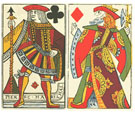
|
| « History of Playing Cards | Early Standards | Gallery of Playing Cards | Card Games | Card Backs |
Origin of French Suit Symbols
Like all stories about playing cards and their origins this one is vested with legend and mystique. But unlike so many other mysteries in the history of playing cards, the origin of French suit symbols can be traced back to one person, Étienne Vignoles.
When playing cards first entered Europe around the mid 1300s the original suit symbols were Cups, Swords, Coins and Batons. These were duplicated by the Italians almost without modification and put into circulation throughout Europe.
From here it is generally thought that playing cards journeyed along three main routes. The first was westward into Belgium, France, Spain and Portugal. The second, was north and westward up through Switzerland and into southwest Germany. The third, north and eastward into Austria, Bohemia and Silesia so that by the 1370s playing cards were well vested in European culture.
National fervor saw the development of a number of variances in suit symbol design. The Spanish, for example, changed the thin, light, sharp pointed rapiers of Swords into heavy, two-edged Roman blades. Similarly, the narrow batons of earlier Italian and Mamaluke designs became heavy clubs lumpy with nodules. Both these weapons were set out in the Spanish designs, in straight and parallel patterns in contrast to the interlaced renditions of the Italian pack.
By the middle of the 15th century the Germans and Swiss were producing particularly exquisite playing cards. There, out of Cups, Coins, Swords and Batons emerged the suit symbols of Hearts, Bells, Leaves and Acorns, each an elegant detailed design embellished with colour so that Hearts and Bells were red, and Leaves and Acorns green.
The European designs always seemed to represent the divisions of society. Hearts are said to represent the Church, and Bells the nobility while Leaves and Acorns, the middle classes and the peasantry respectively.
Throughout the 15th century France had been churning out cards across her various regions and by the 1480s there emerged the suit symbol designs of Cœurs, Carreaux, Trefles and Piques. These are the Hearts, Diamonds, Clubs and Spades of the English and French Packs. Cœurs, or Hearts represented the Church, the Holy men or virtue; Carreaux, or Diamonds were arrowheads, symbolic of the vassals from whom the archers and bowmen were drawn; Trefles or Clubs, deriving from clover, represented the shepherds or husbandman; and Piques, the points of lances – Spades, the knights themselves.
Étienne Vignoles, also known as Lahire, is the valet said to be responsible for their appearance. It is said that he and a friend, Étienne Chavalier, worked on them together. As well as coming up with the suit symbols that would become an indelible characteristic of the French design, they are also said to have devised the game of Piquet which is still regarded to this day, as one of the finest card games for two players.
Of course, these two men weren’t just anybody. Lahire was a famous knight to King Charles 7th and Étienne Chavalier, his loyal secretary. Lahire’s reputation goes far and wide, as already having a reputation as a fierce skirmish-hardened warrior against the English. This was galvanized when he and Joan of Arc rode alongside each other and ploughed spear-long into an English column wrecking their contingency. The scuffle ended later that day with the fall of Augustins – the English H.Q., and the dismantling of the siege of Orleans (1429). After that came the march to Reims, and a succession of towns all the way till the last of the English were brushed off the shores of Gascony 1453.
Étienne Chavalier, like his friend Lahire, was also in the service of the House of Valois and, so it seems, had a reputation as a clever and crafty draughtsman. No doubt active in the promotion of chivalry and other selfless virtues, it seems he also liked to get people interested in the game of cards. In those days you played for money. So is it any wonder, if he played cards anything like he played draughts, there’d be no stopping him.
The popularization of Piquet in gaming houses and royal courts across a brave, new and victorious France explains why they began to omit the 2, 3, 4 and 5 from the pack. Piquet only requires 36 cards. Likewise, Écarté, which became popular there in the mid 17th century, and eventually evolved into the game of Euchre among the French Colonists in America, New Orleans.
French Regional Patterns of the 18th Century |
|

|
By the beginning of the Eighteenth century, war, and no doubt extravagance, had drained France's national treasury to little more than copper coins in a tin pot. In 1701 a new duty was imposed on playing cards of 18 deniers a deck. In order to collect the new tax, the country was divided into nine manufacturing regions. Each manufacturer was required to submit a design block to the ‘Recettes generales’. It was in this manner that each region was allotted its own design. Read More » |
Early Standard Playing Cards |
|

|
Very little is known about the history of card making in England. However, through a pictorial history of French, English and American patterns it is clear to see the origins of the English Pattern and its patrimony in the French Rouen design. |
Card Masters of the 19th Century
|
L I N K S
| ||||||||
| ||||||||
| ||||||||
|
||||||||
|